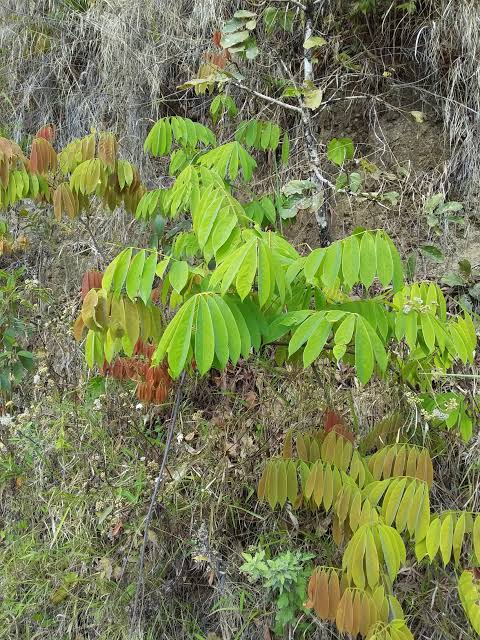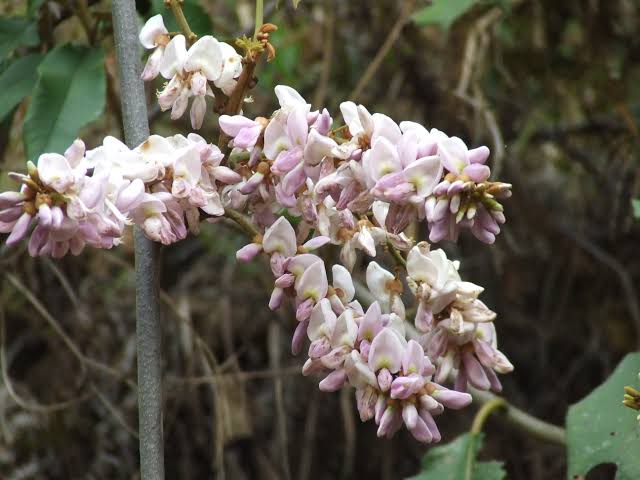Millettia pachycarpa is a lesser-known medicinal plant with remarkable potential for various health benefits. While it might not have a common name in English, it has a rich history of traditional use in certain regions. In this article, we will explore the unique properties of Millettia pachycarpa and its potential for improving human health.
The Botanical Description of Millettia pachycarpa
Millettia pachycarpa is a fascinating plant with distinctive botanical features. Here is an overview of its characteristics:
1. Appearance: This plant is a deciduous shrub or small tree that can grow up to 4 meters in height. It often has a bushy appearance with woody branches.
2. Leaves: The leaves of Millettia pachycarpa are pinnate, meaning they consist of multiple leaflets attached to a central stem. Each leaflet is oblong, with a glossy green surface.
3. Flowers: The plant produces attractive, bright pink to reddish-purple flowers that are arranged in clusters. These blooms add to its visual appeal and are a key identifying feature.
4. Fruits: Millettia pachycarpa produces slender pods or legumes that contain seeds. The pods are typically brown and can reach lengths of 10-15 cm.
5. Habitat: This plant thrives in tropical and subtropical regions, often found in wooded areas, forests, and along riverbanks. It prefers well-drained soils and can tolerate a range of environmental conditions.
6. Aroma: While not well-known for its aroma, some parts of the plant may have a subtle, pleasant scent.
7. Traditional Uses: Millettia pachycarpa has been used in traditional medicine for various purposes, including its potential to treat gastrointestinal issues, respiratory conditions, and more.
This unique combination of characteristics makes Millettia pachycarpa a plant of interest for both botanical enthusiasts and those seeking natural remedies.
The Geographic Distribution of Millettia pachycarpa
1. Native Range: Millettia pachycarpa is native to various regions in Southeast Asia, including countries like Thailand, Myanmar, Laos, and Cambodia. It thrives in the tropical and subtropical climates of these areas.
2. Wider Distribution: Over time, Millettia pachycarpa has been introduced and cultivated in other parts of the world with similar climates. This includes regions of South Asia and some parts of Africa, where it has adapted well.
3. Ecological Significance: In its native range, Millettia pachycarpa plays an ecological role as part of the local flora, providing nectar for pollinators and serving as a food source for certain wildlife. Its distribution is influenced by the availability of suitable habitats.
The Chemical Composition of Millettia pachycarpa
1. Flavonoids: Millettia pachycarpa is known to contain various flavonoids, which are natural compounds with antioxidant properties. Flavonoids contribute to the plant’s potential health benefits by neutralizing harmful free radicals in the body.
2. Alkaloids: Some species within the Millettia genus are known to contain alkaloids, which can have diverse effects, including potential analgesic and anti-inflammatory properties.
3. Saponins: Saponins are compounds found in Millettia pachycarpa that have been studied for their possible antimicrobial and anti-inflammatory effects. They play a role in traditional medicine.
4. Triterpenoids: Triterpenoids are compounds with various biological activities, and they are found in some species of Millettia. These compounds can contribute to the plant’s medicinal properties.
5. Secondary Metabolites: Millettia pachycarpa produces a range of secondary metabolites, which can have different effects on the body. These include compounds that are currently under investigation for their potential benefits.
The Harvesting and Processing of Millettia pachycarpa
1. Harvesting: The harvesting of Millettia pachycarpa typically involves collecting leaves, stems, or other plant parts depending on the intended use. Harvesting is often done when the plant is in its flowering or fruiting stage.
2. Drying: After harvesting, the plant material is dried to reduce moisture content. Proper drying techniques are essential to preserve the plant’s chemical composition and medicinal properties.
3. Processing: Once dried, the plant material can be processed into various forms, such as powders, extracts, or tinctures. These processed forms make it easier to use for medicinal purposes.
4. Traditional Preparation: In traditional medicine, parts of Millettia pachycarpa are often brewed into herbal teas or prepared as poultices. The preparation method may vary depending on the specific health concern being addressed.
Harvesting and processing Millettia pachycarpa require careful attention to maintain the plant’s beneficial properties while making it accessible for various applications, from herbal remedies to supplements.
Read Also: How to Identify and Treat Diseases on your Fish Farm
The Medicinal Health Benefits Of Millettia pachycarpa

Millettia pachycarpa is a plant with a history of traditional use in various cultures, offering potential medicinal health benefits:
1. Digestive Health: Millettia pachycarpa has been traditionally used to soothe digestive discomfort. Compounds in the plant may help alleviate indigestion, reduce bloating, and promote healthy digestion.
2. Respiratory Support: The plant is believed to have properties that can benefit respiratory health. It may assist in relieving symptoms of respiratory conditions such as coughs and bronchitis.
3. Anti-Inflammatory Effects: Millettia pachycarpa contains compounds that have anti-inflammatory properties. These compounds can help reduce inflammation and swelling, potentially offering relief from conditions such as arthritis.
4. Antioxidant Properties: The presence of antioxidants in the plant can assist in neutralizing harmful free radicals in the body. This can boost the immune system and protect against chronic diseases.
5. Stress Reduction: Some traditional uses of Millettia pachycarpa suggest that it may have mild sedative effects, aiding in reducing stress and anxiety, promoting relaxation and improving overall well-being.
The Methods of Usage to Achieve the Provided Health Benefits Of Millettia pachycarpa
To harness the potential health benefits of Millettia pachycarpa, various methods of usage are employed:
1. Herbal Infusion: Prepare a herbal infusion by steeping dried Millettia pachycarpa leaves in hot water. This tea can be consumed to address digestive discomfort and support respiratory health.
2. Aromatherapy: Inhaling the aroma of Millettia pachycarpa essential oil through aromatherapy may promote relaxation, reduce stress, and potentially assist with respiratory conditions. Use it in a diffuser.
3. Topical Applications: Creams or ointments containing Millettia pachycarpa extracts can be applied to the skin to reduce inflammation and soothe conditions like arthritis or muscle pain.
4. Culinary Use: Incorporate fresh or dried Millettia pachycarpa leaves into your cooking to enhance flavor and potentially gain digestive benefits.
5. Tinctures and Supplements: Millettia pachycarpa is available in tincture or supplement form for more concentrated usage. Follow recommended dosages for specific health concerns.
The Side Effects Of Using Millettia pachycarpa Medicinal Plant
While Millettia pachycarpa offers potential health benefits, it’s important to be aware of possible side effects:
1. Allergies: Some individuals may be allergic to Millettia pachycarpa, experiencing skin rashes or respiratory issues upon contact or inhalation.
2. Gastrointestinal Upset: Excessive consumption of Millettia pachycarpa may lead to gastrointestinal discomfort in some individuals.
3. Medication Interactions: Millettia pachycarpa supplements or extracts may interact with certain medications. Consult with a healthcare professional, especially if you are taking other medications.
4. Pregnancy and Lactation: Pregnant and breastfeeding individuals should use caution and consult with a healthcare provider before using Millettia pachycarpa medicinally, as its effects during these periods are not well-documented.
5. Skin Sensitivity: Applying concentrated Millettia pachycarpa essential oil directly to the skin can lead to skin sensitivity or irritation in some cases. Dilution is essential, and a patch test is advisable before use.
Read Also: 24 Medicinal Health Benefits Of Linaria vulgaris (Butter and Eggs)
The Scientific Research and Studies of Millettia pachycarpa

1. Antioxidant Properties: Scientific studies have explored the antioxidant potential of Millettia pachycarpa, focusing on the plant’s flavonoid content. These antioxidants are found to play a role in protecting cells from oxidative stress, potentially contributing to overall health.
2. Anti-Inflammatory Effects: Research has investigated the anti-inflammatory properties of the plant’s compounds. Studies suggest that these may have a role in reducing inflammation and providing relief from inflammatory conditions.
3. Traditional Medicine: While not strictly scientific, there is a wealth of knowledge from traditional medicine practices involving Millettia pachycarpa. This includes its historical usage for digestive and respiratory health and its potential benefits in these areas.
4. Alkaloids and Bioactive Compounds: Some studies have examined the alkaloids and bioactive compounds present in Millettia pachycarpa. These compounds are subjects of interest for their potential medicinal properties and are a focus of ongoing research.
5. Ethnobotanical Research: Ethnobotanical studies have explored the traditional uses of Millettia pachycarpa in different cultures, shedding light on its historical significance and therapeutic applications.
Safety Precautions and Recommendations In Using Millettia pachycarpa Medicinal Plant
1. Allergies: Be cautious if you have known allergies to plants in the same family as Millettia pachycarpa. Perform a patch test if using the plant topically.
2. Dosage: When using concentrated forms of Millettia pachycarpa, such as essential oil or supplements, adhere to recommended dosages to prevent adverse effects.
3. Medication Interactions: Consult with a healthcare professional if you are taking medications, as there may be potential interactions with Millettia pachycarpa.
4. Pregnancy and Lactation: Pregnant and breastfeeding individuals should exercise caution and seek professional advice before using Millettia pachycarpa medicinally.
5. Skin Sensitivity: Dilute essential oil properly before applying it to the skin to prevent skin sensitivity or irritation. Perform a patch test if needed.
FAQs About Millettia pachycarpa
Q1: Can I use Millettia pachycarpa as a replacement for prescription medications?
A1: Millettia pachycarpa should not be used as a replacement for prescribed medications. Consult with a healthcare provider for specific health concerns.
Q2: Is there a recommended dosage for Millettia pachycarpa supplements?
A2: Recommended dosages for supplements may vary. Follow the instructions on the product label or consult with a healthcare professional.
Q3: Are there any known adverse reactions to Millettia pachycarpa essential oil?
A3: Some individuals may experience skin sensitivity or allergies to essential oils. Perform a patch test and dilute properly before use.
Q4: Can I grow Millettia pachycarpa at home for personal use?
A4: It is possible to cultivate Millettia pachycarpa in suitable climates. However, ensure you are aware of the plant’s growth requirements and local regulations.
Q5: Is Millettia pachycarpa suitable for children or pets?
A5: Exercise caution when using Millettia pachycarpa around children and pets. Their sensitivity may vary, so ensure proper dilution and ventilation.
Read Also: Broccoli Farming 101: Tips and Techniques for a Thriving Crop






